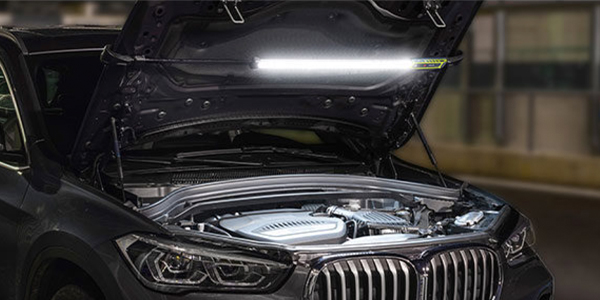
This article is the third in a series on battery electric vehicles (BEVs) and hybrid electric vehicles (HEVs). Find the first article here and the second article here.
In previous installments of this series on electric vehicles (EVs), we covered topics such as the importance of battery precautions and welding safety. Working safely with high-voltage (HV) systems is of the utmost importance. As such, we will continue to lightly touch on that in this installment, but the focus this time will be on the tools and equipment needed to properly work on HV systems.
Electrical Systems
Although modern EVs vastly differ from one another, they all have one thing in common: an HV electrical system. HV is defined as having greater than 30 volts AC current or 60 volts DC current. Whenever high-voltage is discussed, it should be mentioned that special protective gear and equipment is required to disable/isolate the battery or to perform work on these systems.
Specialized Hand Tools
In addition to special safety gear, working on HV systems requires specific and specialized tools as well. Grabbing any off-the-shelf screwdriver or wrench is not going to cut it when performing work on an HV system. Specialized tools that are insulated for high-voltage are necessary. These specialized tools are typically rated for up to 1,000 volts and are either made out of a non-conductive material, such as plastic, or may be coated to insulate it from electricity. Care must be taken with these tools to ensure that their insulative properties are not compromised. Tossing them in with the rest of the tools in the toolbox can cause abrasions or cuts to the insulation, allowing electricity to flow through them and into the technician.
Other Tools
In addition to common hand tools, HV systems also require specialty tools for reading the power of the battery and the system in volts and amps. These tools are not only designed to be insulated from high-voltage, they’re designed to safely have high-voltage and amperage run through them. Just like the hand tools, these electrical testers and meters need to be handled with care – not only to ensure proper functionality but to minimize the risk of compromising the tool’s insulative properties and increasing the risk of deadly electric shock.
Attempting to use a standard DVOM on an HV system will almost undoubtedly have disastrous results.
An HV digital volt ohm meter (DVOM) is likely the most common tool that will be used with an HV system. As the name implies, this meter is designed for HV applications and typically can handle up to 1,000 volts. Attempting to use a standard DVOM on an HV system will almost undoubtedly have disastrous results. In addition to the risk of deadly electrocution, the DVOM will almost assuredly be destroyed.
Electrical measurement tools are categorized at different levels, from CAT I to IV. The following are brief explanations of each level:
CAT I. Category I is for measurements performed on circuits not directly connected to mains. Examples are measurements on circuits not derived from mains and specially protected (internal) mains-derived circuits. In the latter case, transient stresses are variable; for that reason, IEC 61010-1-5.4.1(g) requires that the “transient withstand capability” of the equipment is made known to the user.
CAT II. Measurement category II is for measurements performed on circuits directly connected to the low-voltage installation. Examples are measurements on household appliances, portable tools and similar equipment
CAT III. Measurement category III is for measurements performed in the building installation. Examples are measurements on distribution boards, circuit-breakers, wiring (including cables), busbars, junction boxes, switches, socket-outlets in the fixed installation, and equipment for industries.
CAT IV. Measurement category IV is for measurements performed at the source of the low-voltage installation. Examples are electricity meters and measurements on primary overcurrent protection devices and ripple control units
For HV measurement purposes, a minimum of a CAT III meter is required. However, the use of CAT IV is preferred as it adds a better layer of protection when working on a high-voltage system.
Proper Usage
Having the right tool and using it correctly are two different things. Other than the safety factor of using the HV-DVOM correctly, it is necessary to know how to obtain proper readings. Testing the meter on a known low-voltage source, such as the vehicle’s 12-volt battery, is the first step. This allows the technician to verify not only the proper use of the tool but tool accuracy as well.
Faulty meters or leads can produce a false “zero voltage” reading. You’re better off discovering an issue with low-voltage than with high-voltage. Because the HV system circuits are isolated from the vehicle chassis ground, the leads must take readings directly from the HV connections. OEMs will typically provide information on where to measure. Depending on the work that is being performed, the locations to measure may be HV cable ends, connectors or the battery itself.
I-CAR HEV/BEV Courses
- Hybrid Vehicle Identification and Damage Analysis
- Hybrid, Electric and Alternative Fuel Vehicle Service
- Introduction to Electric Vehicles
- Understanding High Voltage Safety
- Electric Vehicle Inspection and Handling
- Electric Vehicle Damage Analysis
- Electric Vehicle Service Considerations
Another HV tool is a two-pole voltage meter. As the name implies, this tool measures only voltage. Unlike a DVOM, this tool is not dependent on an internal battery to perform its functions. This means that there is no failure to read or reading inaccuracy that can occur due to a low or dead internal battery. In addition, unlike the DVOM, there are no settings to adjust or select. This eliminates the potential of having the meter on the wrong setting. Just as with the HV-DVOM, it is a good idea to test the two-pole voltage meter on a known low-voltage source. These meters will often have a function that will allow the technician to simply press a button or buttons on the tester to place a slight load on the circuit, allowing any residual or “ghost” voltage remaining in the circuit after isolation or disconnection to be dissipated. It is important to note that this feature is not designed to discharge a capacitor.
Testing for Voltage
When testing for voltage on an HV system, a good practice is to not only test for voltage between HV+ and HV- but to also test for HV+ to vehicle ground and HV- to vehicle ground (chassis). This helps to identify any potential faults in the HV system that have allowed the high-voltage to break containment and now be flowing through the vehicle chassis. This is important as the possibility of this voltage breach is heightened in the event of a collision but can also occur due to chaffing, chemical deterioration or cuts that compromise the HV wiring insulation.
Once you’ve confirmed your voltage with the three-step process, there is still one more step. Take your DVOM or two-pole voltage meter and go back to the same low-voltage source you tested on and take another reading. This is another safety step that helps ensure that there was not an error with the function of the tool when testing the HV system.
Milliohm Meter
Another tool that is needed for HV systems is a milliohm meter, which will measure very small amounts of electrical resistance. A milliohm is 1/1000th of an ohm.
Measuring such a small amount of electrical resistance is accomplished by two probes that each have two terminals. One of the terminals on each probe provides an electrical charge of typically one amp. The other terminal on each probe reads voltage. This allows the tool to determine the resistance in ohms by applying ohms law, which has an exact and constant relationship between volts, amps and ohms. The tool calculates this quickly and accurately.
With an HV system, due to the high amount of volts and amps, even the smallest resistance in the wiring or components of the system is going to cause issues. Being able to accurately identify and read these small amounts of resistance is imperative and is something a standard ohm meter or DVOM simply cannot do. Accurate measurement in milliohms is important to measure bonding of an HV component to the chassis. Only a good bonding allows the insulation guard in the CU to detect insulation arrows.
Summary
Having the proper tools for testing and repairing HV systems is important not only for safety but for accurate electrical measurements as well. Having the right tools is the first step when working with HV systems; knowing how to properly use them is the next one.
This article courtesy of BodyShop Business.














